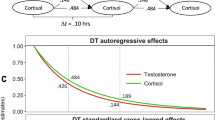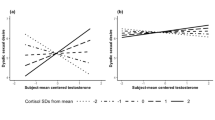Abstract
Strong relationships between one-time serum testosterone (T) measures and sexual activityhave been demonstrated in cross-sectional analyses of adolescent males. However, a subsequent longitudinal study of a separate adolescent sample, using semiannual plasma measures, failed to replicate cross-sectional findings. The present study reexamined the relationship between T and sexual activity using more frequently collected measures of salivary T and behavior. Saliva samples and weekly behavior checklists were collected over a 2-year period from the same panel sample of males on which semiannual analyses were based. Saliva samples representing measures approximately every fourth week of study participation were selected for T assay. The association between these monthly salivary T measures and weekly reports of incidents of sexual activity was assessed with repeated measures analyses. Higher levels of salivary T were significantly associated with an increasing hazard of coital initiation, and with more frequent coital and noncoital activity. Within-individual change analyses demonstrated that increases in salivary T were associated with increased sexual activity. Comparisons of models that varied specimen type, schedule of T measurement, and type of behavioral report indicated that all three factors contribute to the varying magnitude of hormone/behavior relationships that are demonstrated. These findings are consistent with a biosocial model of adolescent sexual development that pubertal changes in T are a causal factor in the timing of sexual initiation and the frequency of activity during adolescence.
Similar content being viewed by others
REFERENCES
Bentler, P. M. (1968a). Heterosexual behavior assessment-I. Males. Behav. Res. Ther. 6: 21–25.
Bentler, P. M. (1968b). Heterosexual behavior assessment-I. Females. Behav. Res. Ther. 6: 27–30.
Brown, W. A., Monti, P. M., and Corriveau, D. P. (1978). Serum testosterone and sexual activity and interest in men. Arch. Sex. Behav. 7: 97–103.
Butler, G. E., Walker, R. F., Walker, R. V., Teague, P., Riad-Fahmy, D., and Ratcliffe, S. G. (1989). Salivary testosterone levels and the progress of puberty in the normal boy. Clin. Endocrinol. 30: 587–596.
Cox, D. R. (1972). Regression models and life tables (with discussion). J. Roy. Statist. Soc, Series B 34: 187–220.
Dabbs, J. M., Jr., Campbell, B. C., Gladue, B. A., Midgley, A. R., Navarro, M. A., Read, G. F., Susman, E. J., Swinkels, L. M. J. W., and Worthman, C. M. (1995). Reliability of salivary testosterone measurements: A multicenter evaluation. Clin. Chem. 41: 1581–1584.
Davidson, J. M., Camargo, C. A., and Smith, E. R. (1979). Effects of androgens on sexual behavior of hypogonadal men. J. Clin. Endocrinol. Metab. 48: 955–958.
Halpern, C. T., and Udry, J. R. (1992). Variation in adolescent hormone measures and implications for behavioral research. J. Res. Adolescence. 2: 103–122.
Halpern, C. T., Udry, J. R., Campbell, B., and Suchindran, C. (1993). Testosterone and pubertal development as predictors of sexual activity: A panel analysis of adolescent males. Psychosom. Med. 55: 436–447.
Halpern, C. T., Udry, J. R., and Suchindran, C. (1994a). Effects of repeated questionnaire administration in longitudinal studies of adolescent males' sexual behavior. Arch. Sex. Behav. 23: 41–57.
Halpern, C. T., Udry, J. R., Campbell, B., Suchindran, C., and Mason, G. A. (1994b). Testosterone and religiosity as predictors of sexual attitudes and activity among adolescent males: A biosocial model. J. Biosoc. Sci. 26: 217–234.
Halpern, C. T., Udry, J. R., and Suchindran, C. (1997). Testosterone predicts initiation of coitus in adolescent females. Psychosom. Med. 59: 161–171
Jaccard, J., and Wan, C. K. (1995). A paradigm for studying the accuracy of self-reports of risk behavior relevant to AIDS: Empirical perspectives on stability, recall bias and transitory influences. J. Appl. Soc. Psycol. 25: 1831–1858.
Kraemer, H. C., Becker, H. B.; Brodie, H. K. H., Doering, C. H., Moos, R. H., and Hamburg, D. A. (1976). Orgasmic frequency and plasma testosterone in normal human males. Arch. Sex. Behav. 5: 125–132.
Luisi, M., and Franchi, F. (1980). Double-blind group comparative study of testosterone undecanoate and mesterolone in hypogonadal male patients. J. Endocrinol. In vest. 3: 305–308.
O'Carroll, R., Shapiro, D., and Bancroft, J. (1985). Androgens, behavior and nocturnal erections in hypogonadal men: The effect of varying there placement dose. Clin. Endocrinol. 23: 527–538.
Raboch, J., and Starka, L. (1973). Reported coital activity of men and levels of plasma testosterone. Arch. Sex. Behav. 2: 310–315.
Rilling, J. K., Worthman, C. M., Campbell, B. C., Stallings, J. F., and Mbizvo, M. (1996). Ratios of plasma and salivary testosterone throughout puberty: Production vs. bioavailability. Steroids 61: 374–378.
Salmimies, P., Kockott, G., and Pirke, K. M., Vogt, H. J., and Schill, W. B. (1982). Effects of testosterone replacement on sexual behavior in hypogonadal men. Arch. Sex. Behav. 11: 345–353.
Sannikka, E., Terho, P., Suominen, J., and Santti, R. (1983). Testosterone concentrations in human seminal plasma and saliva and its correlation with non-protein bound and total testosterone levels in serum. Int. J. Androl. 6: 319–330.
SAS Institute, Inc. (1993). SAS Technical Report P-243, SAS/5TAT Software, The GENMOD Procedure, Release 6.09, Cary, NC.
Skakkebaek, N. E., Bancroft, J., Davidson, D. W., and Warner, P. (1981). Androgen replacement with oral testosterone undecanoate in hypogonadal men: A double blind controlled study. Clin. Endocrinol. 14: 49–61.
Smith, E., and Udry, J. R. (1985). Coital and noncoital sexual behaviors of white and black adolescents. Am. J. Public Health 75: 1200–1203.
Stevens, J. (1986). Applied Multivariate Statistics for the Social Sciences, Erlbaum, Hillsdale, NJ.
Udry, J. R., Billy, J. O. G., Morris, N. M., Groff, T. R., and Raj, M. H. (1985). Serum androgenic hormones motivate sexual behavior in adolescent boys. Fertil. Steril. 43: 90–94.
Wang, C., Plymate, S., Nieschlag, E., and Paulsen, A. (1981). Salivary testosterone in men: further evidence of a direct correlation with serum testosterone. J. Clin. Endocrinol. Metab. 53: 1021–1024.
Rights and permissions
About this article
Cite this article
Halpern, C.T., Udry, R. & Suchindran, C. Monthly Measures of Salivary Testosterone Predict Sexual Activity in Adolescent Males. Arch Sex Behav 27, 445–465 (1998). https://doi.org/10.1023/A:1018700529128
Issue Date:
DOI: https://doi.org/10.1023/A:1018700529128




